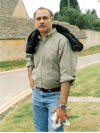|
|
the-south-asian.com July / August 2006 |
|
|||
|
August/September Contents
Sufis - wisdom against 50
years of mountain Heritage cities:
Cotton - the fibre of
|
|
||||
|
Page 3 of
4 Sufis - Wisdom against Violence (cntd.) by Salman Minhas
First published April 2001
The Grand Master - Baba Farid Shakar Ganj of Pak Pattan [AD 1173-1266] Najam Hosain Syed (ex- Head, Punjab University Punjabi Department, Lahore writer & poet of "Takhte Lahore " a play performed in India), writing in his excellent book "Recurrent Patterns in Punjabi Poetry", refers to Baba Farid as standing at the far end of Punjabi poetic tradition in eminent isolation. Nearly three centuries pass before another figure of any status relieves the curious blank." Najam comments on the uncompromising "austere rhythms of Farid " and the use of the "Dohras" as a rhymed couplet, reflecting a poise, serenity, grim yet confident, volatile, meaningful use as the following verses show.
Note the old Italian
saying and caveat about translations - " The Translator is a
To quote from Najam Hosainís brilliant essay - .... " The passivity induced by the evenness of rhythm is suddenly shattered when the last part of the second line - " and people call me a dervish" clinches the meaning, putting the rest of the verse in an intense blend of irony and pathos. Black clothes worn by pious men as a sign of humility become associated in the minds of men with an undefined piety. But for the poet, black symbolizes his erring self ... there is a quality of haunting mockery in Faridís repetitive insistence on the word "black"..." The reader may know that the Holy Prophet Mohammed [ PBUH] is also referred in qawwalis as " Kali kambli waley " [the one with the black cloak ].
Najam goes on to show how the poet resolves this young womanís nagging hesitant situation of her inner self and the prudent cautioning of reputation. The above example is one of the uses of the two lines for a volatile purpose. Najam then gives another example of the use of the two line couplet [dohra] as depicting a "veiled gravity" in that as long as a person does not attain inner maturity, there is always a need to be mindful and watchful as the Buddha used to say [Better to conquer yourself than to conquer others]. Here is a dohra using the peasant and farming metaphors. " Kook Farid Kook, Tu jivain Rakha Jawar Jab lag tanda na, Giray tab lag Kook pukar." Shout, Farid, shout like the watchful man in the corn-field; As long as the bushel does not mature and fall, shout on" There is no ornamental use of words, there is a veiled gravity in the tone of Farid and the imagery is drawn from sweat of the common peasant farmers. Baba Farid's Life Baba Farid was born on the on the first day of the month of Ramzaan in 1173 in the city of Kothiwal, near Dipalpur in Punjab. It is now called Pak Pattan; the ancient name has been recorded as Ajodhan. The city existed when Alexander invaded in 326 BC. It was an important metropolis on the Multan-Delhi route. The city is on the banks of the river Sutlej. People going across would usually wash [clean = pak] themselves at the ferry [pattan]. Hence the name Pak Pattan .The story goes that, the day Baba Farid was born, a holy man was consulted about the breaking of a fast. He advised that a great soul had been born in the house of Jamal-ud-din Suleiman and that the community could break the fast only when the infant suckled. It is said that the infant Baba Farid was fasting. Baba Faridís ancestors were from a town called Aush, south of Fergana [Baburís hometown] south east of Andijan. Faridís grandfather [Qadi Shuaib] left Kabul and took refuge in Lahore under the Ghaznavid Sultan in 1125. However the gay atmosphere of Lahore did not appeal to his nature and he moved to Kasur above 34 miles southeast of Lahore where the Sultan entrusted him to the Qadi [Kazi- a semi-religious administrator] position. Eventually he left and settled in Kothiwal leaving Kasur. Faridís father Jamal-ud-din Suleiman married the daughter of Sheikh Wajih-ud-din Khojendi called Qarsum Bibi [some say her name was Mariam]. Qarsum was a lady of great piety. According to legend it was she who influenced Farid to pray by placing small cubes of Shakar [brown sugar] under Faridís prayer mat. One day it is said that although she did not place the Shakar, nevertheless there was a piece of Shakar under Faridís mat. Khwaja Bakhtiar Kaki was Baba Faridís "Guru". He was influenced by the Hallaji and Wujjud doctrines, which are essentially spiritual in nature. Kaki met Moinuddin Chishti at Baghdad and being impressed by the man became his disciple. Chishti migrated to Delhi and Kaki followed him, staying for a while in Multan. Because of rivalry and jealousy between some other Sheikhs in Delhi, Moin-ud-din Chishti left for Ajmer. The King at Delhi Balban welcomed Farid in Delhi and introduced him to his family; Balbanís daughter was married to Farid and the gifts for the marriage were distributed among the poor and needy [fakirs]. There is a town called Faridkot in Indian Punjab. Farid is truly the father of Punjabi literature. He died on the 5th of Moharram 1266. Baba Faridís poetry was later to influence the Sikh religion and especially their Holy Book "Sri Guru Granth Sahib" by the founder Guru Nanak. Such was the universality of Baba Farid, the Sufi poet laureate from Punjab.
" Koi Bole Ram Ram koi Khudaee, Koi sevay Gosainyan koi Allah " Some call him Ram, some Khuda Some say Gosain, some Allah. (Guru Arjun Dev - Sri Guru Granth Sahib)
|
|||||
|
Copyright © 2000 - 2006 [the-south-asian.com]. Intellectual Property. All rights reserved. |
|||||
